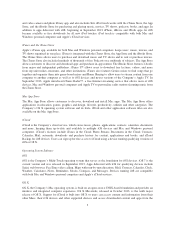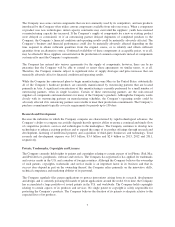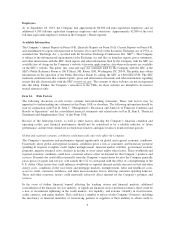Apple 2013 Annual Report Download - page 13
Download and view the complete annual report
Please find page 13 of the 2013 Apple annual report below. You can navigate through the pages in the report by either clicking on the pages listed below, or by using the keyword search tool below to find specific information within the annual report.customer base. Historically, consolidation in this market has resulted in larger competitors. Price competition has
been particularly intense as competitors selling Windows-based personal computers have aggressively cut prices
and lowered product margins. An increasing number of Internet-enabled devices that include software
applications and are smaller and simpler than traditional personal computers compete for market share with the
Company’s existing products. The Company’s financial condition and operating results also depend on its ability
to continually improve the Mac platform to maintain its functional and design advantages.
There can be no assurance the Company will be able to continue to provide products and services that compete
effectively.
To remain competitive and stimulate customer demand, the Company must successfully manage frequent product
introductions and transitions.
Due to the highly volatile and competitive nature of the industries in which the Company competes, the
Company must continually introduce new products, services and technologies, enhance existing products and
services, and effectively stimulate customer demand for new and upgraded products. The success of new product
introductions depends on a number of factors including, but not limited to, timely and successful product
development, market acceptance, the Company’s ability to manage the risks associated with new product
production ramp-up issues, the availability of application software for new products, the effective management of
purchase commitments and inventory levels in line with anticipated product demand, the availability of products
in appropriate quantities and costs to meet anticipated demand, and the risk that new products may have quality
or other defects or deficiencies in the early stages of introduction. Accordingly, the Company cannot determine
in advance the ultimate effect of new product introductions and transitions.
The Company depends on the performance of distributors, carriers and other resellers.
The Company distributes its products through cellular network carriers, wholesalers, national and regional
retailers, and value-added resellers, many of whom distribute products from competing manufacturers. The
Company also sells its products and third-party products in most of its major markets directly to education,
enterprise and government customers, and consumers and small and mid-sized businesses through its online and
retail stores.
Carriers providing cellular network service for iPhone typically subsidize users’ purchases of the device. There is
no assurance that such subsidies will be continued at all or in the same amounts upon renewal of the Company’s
agreements with these carriers or in agreements the Company enters into with new carriers.
Many resellers have narrow operating margins and have been adversely affected in the past by weak economic
conditions. Some resellers have perceived the expansion of the Company’s direct sales as conflicting with their
business interests as distributors and resellers of the Company’s products. Such a perception could discourage
resellers from investing resources in the distribution and sale of the Company’s products or lead them to limit or
cease distribution of those products. The Company has invested and will continue to invest in programs to
enhance reseller sales, including staffing selected resellers’ stores with Company employees and contractors and
improving product placement displays. These programs could require a substantial investment while providing
no assurance of return or incremental revenue. The financial condition of these resellers could weaken, these
resellers could stop distributing the Company’s products, or uncertainty regarding demand for the Company’s
products could cause resellers to reduce their ordering and marketing of the Company’s products.
The Company faces substantial inventory and other asset risk in addition to purchase commitment cancellation risk.
The Company records a write-down for product and component inventories that have become obsolete or exceed
anticipated demand or net realizable value and accrues necessary cancellation fee reserves for orders of excess
products and components. The Company also reviews its long-lived assets, including capital assets held at its
suppliers’ facilities and inventory prepayments, for impairment whenever events or circumstances indicate the
11
























